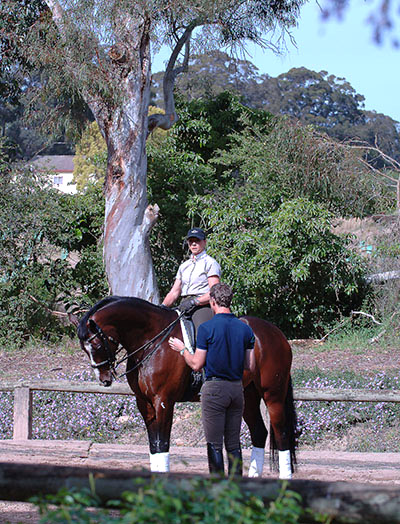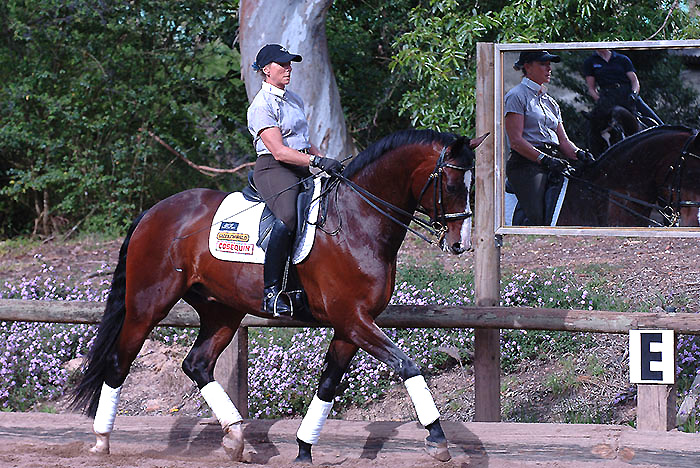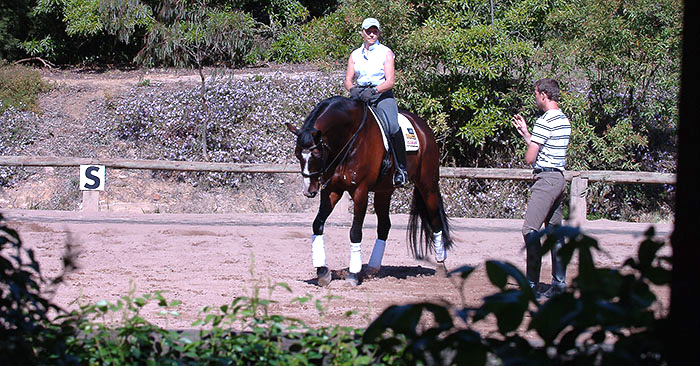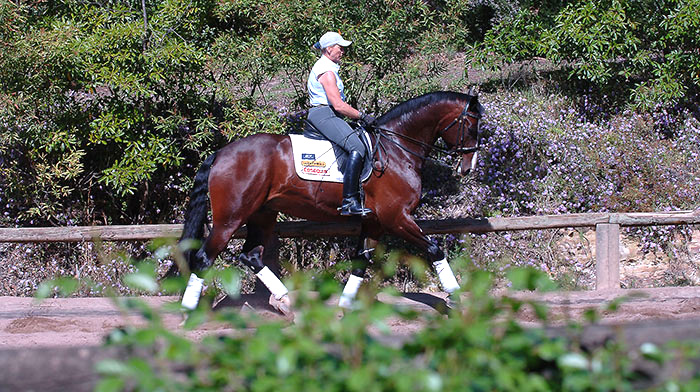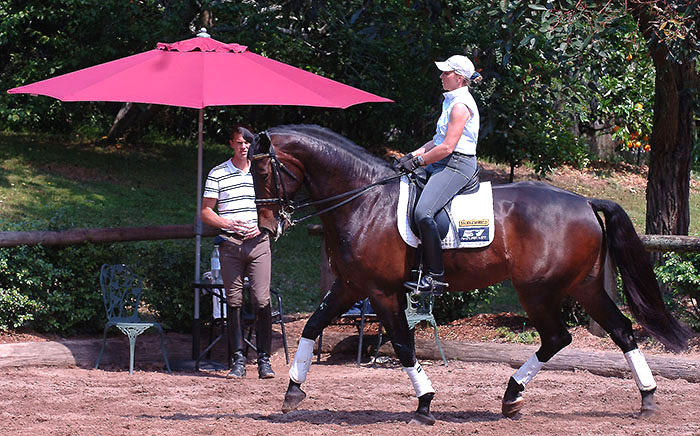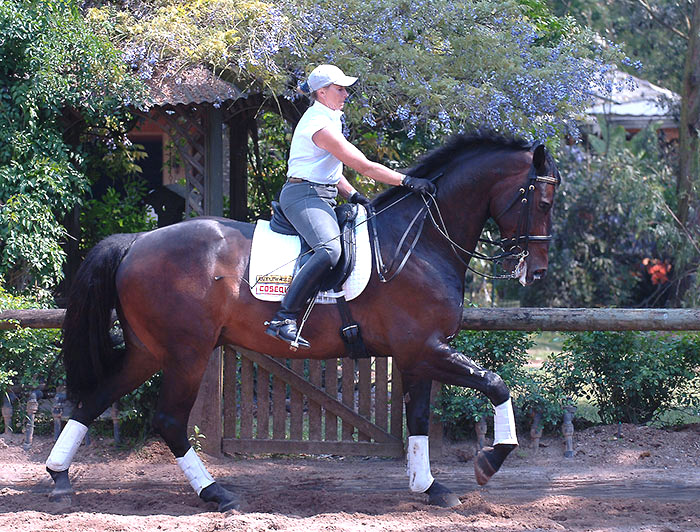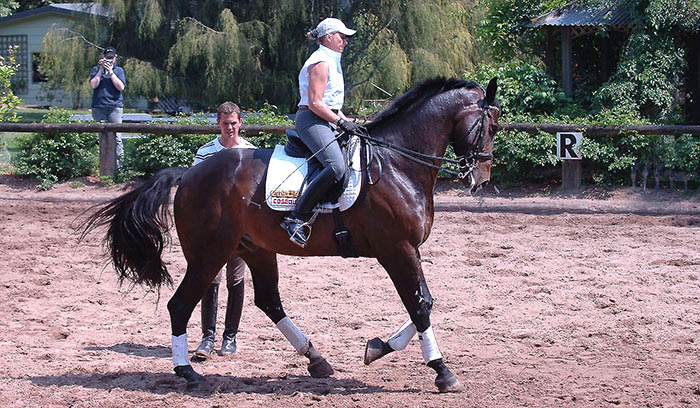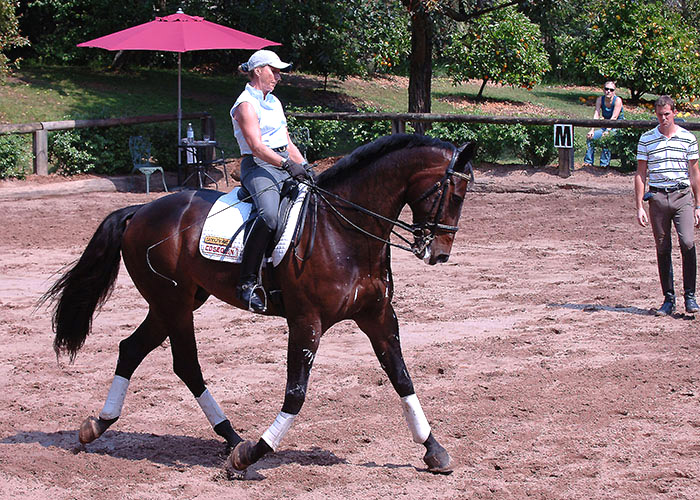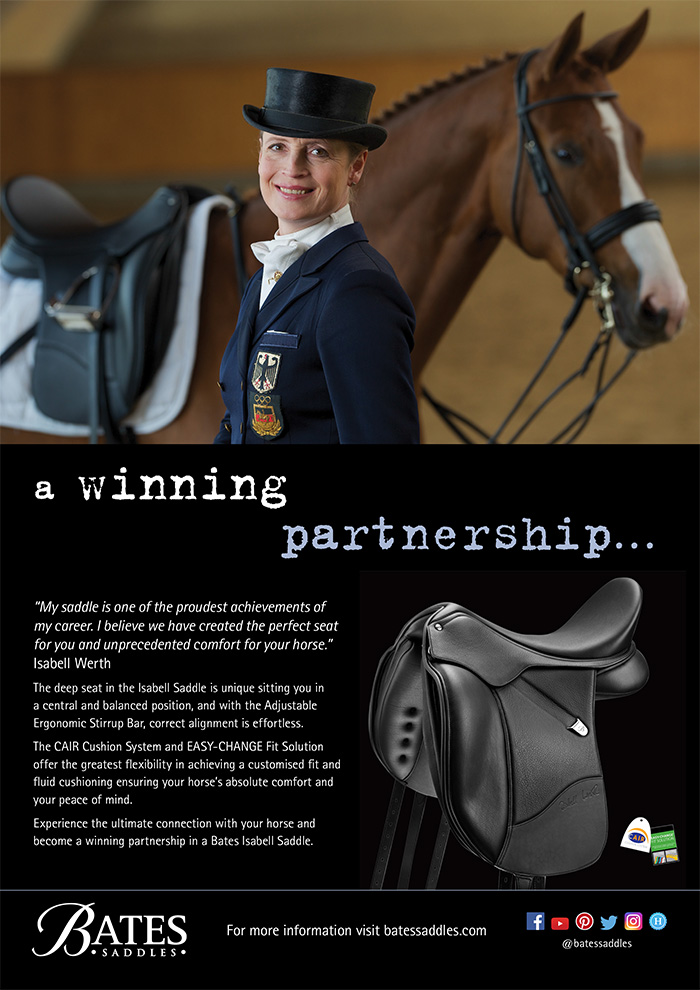Story by Chris Hector and Photos by Roz Neave
Back in 2007, we visited Clemens and Judy Dierks’ Training Stables for another training session with young German trainer, Stefan Wolff. This time the pupil was one of the principals of the Stables, Judy Dierks on two of her rides. First is Andrea Beatty’s De Caprio by De Niro, and then Judy’s own Frontier, of Australian Holstein breeding.
It was easier for Stefan work with Judy Dierks, one Australian dressage rider who works solidly within the German training scale…
Right from the beginning Stefan was working on the gelding’s frame, getting Judy to open him up in the neck, let his nose forward, making him bigger, looser, through the body.
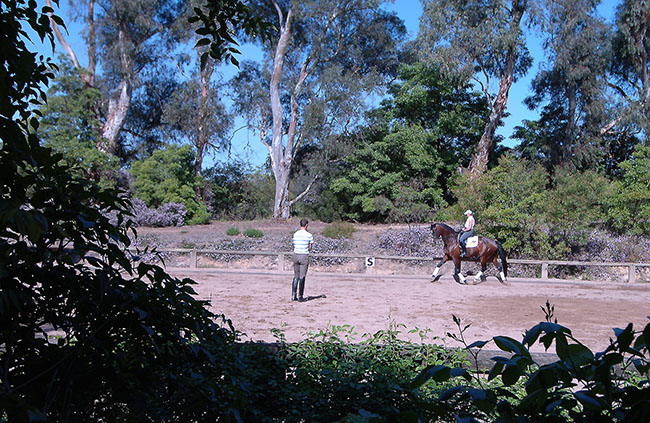
But the trick was to give the rein before the leg aid…
“Give first, then follow with the legs, so he’s not running. If you use the leg aid, then give the reins, the horse will run. Give more, and make him lighter…”
“Ask him to lower his shoulder and neck, and when you feel he gives, leave him alone and follow with your legs. Even if he doesn’t immediately follow your hands, even if you have a lighter contact for a while, just wait. Give, and make him quicker from behind…”
“Bring him back or give – one or the other, don’t be so conservative. You are still a bit stuck with his mouth – bring him back so he stays on your seat. Don’t be scared all the time that he runs off – give, ask him from behind, and give more. Be brave, ride at that second, don’t worry about the neck. You need a response from your leg, don’t worry about the neck. Open his neck. Don’t worry about the half halt, that comes later. Bring him more from behind, an electric response, then give. Tap him with the whip on the croup, and pat him when he responds. The whip is additional to the leg. Keep the legs in a bit of a defensive position – keep the tension in the leg. He’s a little cold to the leg.”
Okay so the Hanoverian gelding was woken up – time to get down to the real deal – getting him longer, freer.
“You must soften the top line. He’s pulling a little bit at the poll. Give and follow with the hand. In the half halts, keep him following the hand. Start at the mouth with the half halt and work up, don’t get stuck in the half halt.”
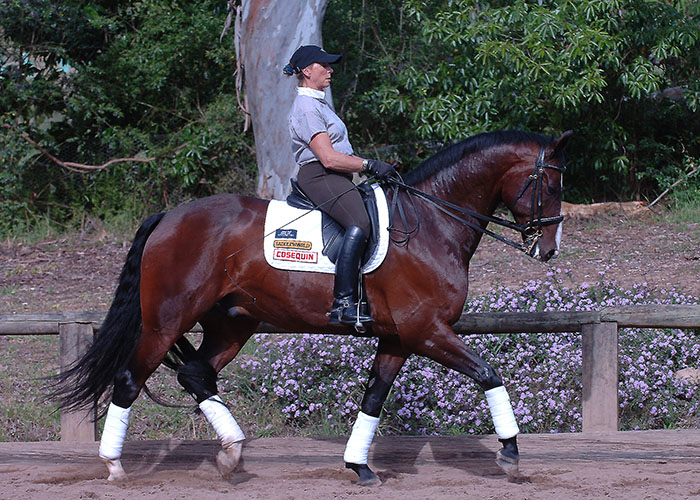
Back to walk: “Give so he goes longer in the neck in the walk, then trot on, and give, give, give. Don’t worry he won’t run off in this arena… First give, then let him follow. Give him the chance to follow. That’s a better frame – give, give, follow, then ride the half halt. It’s one piece after the other.”
“Always when you touch the mouth, think of softening him in the topline – come now, up hill. Move him up at the poll, but very soft, let him go, follow the bit, come on, come on, give and follow!”
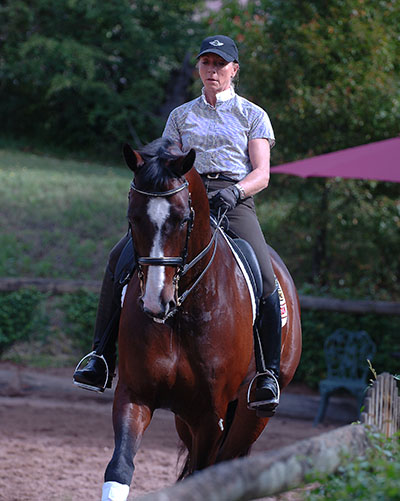
“First you give NOW you ride and make him follow, give and follow, give and follow.”
“The contact is sometimes in a very nice frame, but it is not constant, that means you need a little more activity from behind – always through from the leg. Every step must be from the hindlegs to the centre of gravity.”
“Now you have a better frame – is it a good feeling? And go light, and light, it’s nice there. And more and more every driving aid goes through the body. Half halt, give, more from behind, half halt, soften the topline, and always more from behind.”
“If you get stuck, start again from the mouth, make it supple, half halt and give. That was nice.”
This really was one lesson in which the difference between the shape and feel at the beginning of the lesson, and at the end of the lesson, were so clear and obvious – the gelding had stretched, opened his body and the stride was longer, clearer, ever so much more forward. Amazing!
next we talk to Judy about the training session
Want to breed your own De Niro? Go to: www.ihb.com.au
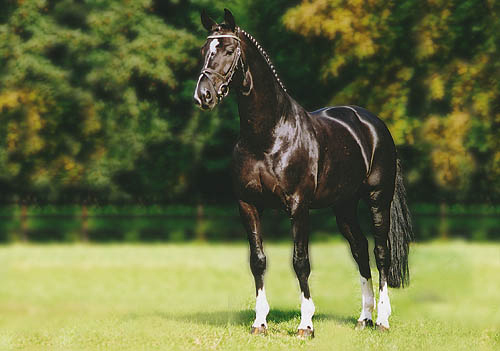
How did it feel? It is interesting that a rider as correct, and as experienced, as Judy, finds Stefan’s lessons both stimulating – and frustrating…
Today’s lesson seemed to be almost entirely about the issue of contact – but that contact was not contact most of the time?
“It’s an issue of having a contact without making a restriction to the horse and without making the horse short. It’s about having a contact, and making an adjustment in the horse, that doesn’t restrict the horse but actually the adjustment has the effect of softening the horse. It’s the idea of allowing the horse forward, not by giving the reins loose, or long, but from the hindleg into a contact in front with the hands allowing the horse to go into the bridle. It’s completely the correct way to ride.”
But I thought it was interesting that at one point, he said, ‘Judy even if he doesn’t come to the bit when you give the rein, don’t give up on the effort’ – let it sit there even if it does lose a little contact for the time and keep working til you get him out there…
“Absolutely. It’s not just the rider, the horse also has to be trained to respond. Nothing is instantaneous, it is not going to happen straight away – but occasionally when you time it right, you feel that flow through the body into the bridle. But of course, at this stage, you only feel it for a moment. So you have to go back again, allow again, and hope that you and the horse can respond to the timing again – it’s definitely about setting the horse up so he is in a lovely self-carriage.”
It was interesting, he was saying, ‘start with the mouth’ each time?
“Just trying to get the horse’s attention in the mouth, but at the same time, trying not to have too much weight in the reins. It is very hard not to have too much weight in the reins but at the same time, still have the rein connection. This is what takes a long time to develop in the training. It’s not instant, it’s possible, and you have to consolidate it over a period of time. It is the way to train and the end result would be of far greater quality.”
“I felt it immediately under my seat, where the horse actually lifted himself off the ground. Then trying to soften the neck just that little bit, to ask again, was where I had the difficulty, to get that little bit of softening so I didn’t block it again. Sometimes I would make the rein aid adjustment – but then I pushed too suddenly, instead of just softening and following the horse. I couldn’t help myself, I’d soften and relax the rein, but as soon as I’d done that, I’d push too hard, and pushed him back into the bridle. That’s what I was having trouble with…”
It was interesting that the minute he had you allowing and following, that his attention immediately went to the other end of the horse? He was saying, hey, this is not quick enough, this is not electric… his work was always so subtle, never just heading in the one direction…
“I felt it was originally about allowing the horse to go into the bridle, but at the same time, that started to coordinate and I started to get a glimpse of how to do it, then Stefan was very concerned – not that I chased the horse – but to make sure the hindlegs were stepping in such a positive self-carriaged way, that I kept engaging and asking him, while at the same time, not blocking him. I definitely felt a big improvement, but that coordination between the ask of the engagement behind into the skill of the reins in front, that’s that the difficult bit – that’s something you have to be searching for all the time. If you can get it, it is amazing.”
But you got it a lot of the time?
“Yeah, yeah, I got it some of the time, but I just need to get it all of the time…”
And if you know Judy, you can probably hear her rolling laugh at this point.
With Judy’s 7-year-old gelding, Frontier, who has already competed at Grand Prix level, Stefan’s message remains the same. The horses have to stretch their necks, come longer, bigger, looser, and freer…
“Don’t lose the relationship between the give and the leg aids – give and follow. As soon as he comes on your seat, give again, but don’t wait too long to give. Feel more the impulsion flowing through the whole horse to your hands. It gets easier, so you don’t have to tell him all the time to follow your hands. Tell him once or twice, but have a very light contact, only the weight of the reins in his mouth.”
Stefan also wanted Frontier a little more ‘natural’ in the passage: “Make him a little lower in the neck to make sure the back comes up in passage, and don’t forget to ride your basic gymnastic work in passage. Bend him, more, more, then allow him to stretch to your hand. Keep the suppleness in his neck, and give and follow the hands. Now give and trot out, first give, then ask from behind.”
“Ask first with the legs, then use the whip if you don’t get a reaction. Get him a little more uphill, then give again. Lighter contact, don’t prevent him going forward, just what you need to get him up for that moment, don’t prevent for the next moment.”
Judy is a master of the half pass, but again, Stefan wanted the movement bigger and more expansive.
“Lower his neck in the corner, then you can give and open him up in the half pass. That’s good, pat him. Don’t wait in the half pass, give and open him out…”
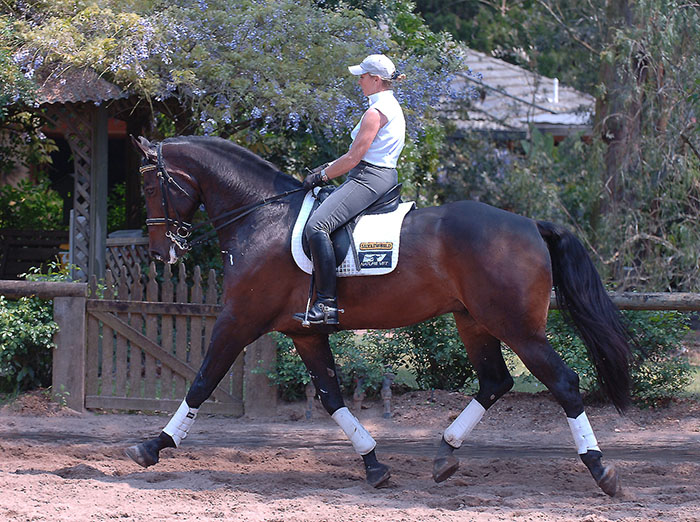
The recipe was much the same for the medium trot: “In the corner you can come back a little, take his neck lower in the corner, then medium on the long side. Give and follow, try to get a longer, bigger frame in the medium. Let him follow so you don’t have to push in the medium, give and let him follow himself.”
Time to work on the canter: “Quicker, quicker, that’s better. We want the collection in this rhythm. That’s better. Now collect, bring back, but quicker. Half halt and give, so that he stays with you in collection. Half halt and give, and he has to stay with you after the half halt. GIVE.”
We see what Stefan keeps coming back to, a method of training, as taught by Klaus Balkenhol, that makes the work as easy and comfortable as possible for the horse and the rider. Always aiming for work that is light and loose, forward and attractive…
Thank you Stefan.
This article originally appeared in THM January 2007.
There are more articles with Stefan right here:

